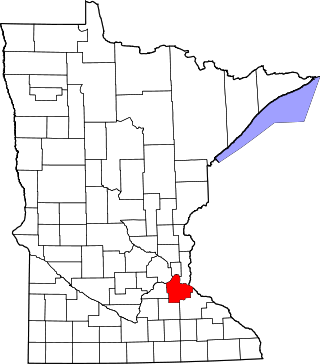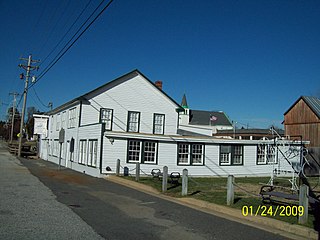
Saint Anthony Falls, or the Falls of Saint Anthony, located at the northeastern edge of downtown Minneapolis, Minnesota, is the only natural major waterfall on the Mississippi River. Throughout the mid-to-late 1800s, various dams were built atop the east and west faces of the falls to support the milling industry that spurred the growth of the city of Minneapolis. In 1880, the central face of the falls was reinforced with a sloping timber apron to stop the upstream erosion of the falls. In the 1950s, the apron was rebuilt with concrete, which makes up the most visible portion of the falls today. A series of locks were constructed in the 1950s and 1960s to extend navigation to points upstream.

The Pillsbury A-Mill is a former flour mill located on the east bank of the Mississippi River in Minneapolis, Minnesota. It was the world's largest flour mill for 40 years. Completed in 1881, it was owned by the Pillsbury Company and operated two of the most powerful direct-drive waterwheels ever built, each capable of generating 1,200 horsepower . In 1901 one of the turbines was replaced with a 2,500 horsepower one. Both the mill and its headrace tunnel are contributing resources to the St. Anthony Falls Historic District, which is on the National Register of Historic Places. The mill is also independently on the NRHP. The mill was named a National Historic Landmark in 1966 and has since been converted into the A-Mill Artist Lofts.

Rapidan is a small unincorporated community in the Virginia counties of Culpeper and Orange, approximately 5 miles (8 km) northeast of the Town of Orange. The community, located on both sides of the Rapidan River, was established in the late eighteenth century around the Waugh's Ford mill. The Orange and Alexandria Railroad built a line through the town in 1854, a post office was built at the river crossing, and its name was changed to Rapid Ann Station. Milling remained a major industry in the area up through the mid-twentieth century.

This is a list of the National Register of Historic Places listings in Dakota County, Minnesota. It is intended to be a complete list of the properties and districts on the National Register of Historic Places in Dakota County, Minnesota, United States. Dakota County is located in the southeastern part of the U.S. state of Minnesota, bounded on the northeast side by the Upper Mississippi River and on the northwest by the Minnesota River. The locations of National Register properties and districts for which the latitude and longitude coordinates are included below, may be seen in an online map.

The Village of East Davenport, also known simply as The Village, is located along the Mississippi River on the southeast side of Davenport, Iowa, United States. It was listed as a historic district on the National Register of Historic Places in 1980 as the Davenport Village. At the time of its nomination it included 145 contributing properties, most of which were working-class housing.

This list is of the properties and historic districts which are designated on the National Register of Historic Places or that were formerly so designated, in Hennepin County, Minnesota; there are 190 entries as of April 2023. A significant number of these properties are a result of the establishment of Fort Snelling, the development of water power at Saint Anthony Falls, and the thriving city of Minneapolis that developed around the falls. Many historic sites outside the Minneapolis city limits are associated with pioneers who established missions, farms, and schools in areas that are now suburbs in that metropolitan area.

J. C. Lore Oyster House, also known as J. C. Lore and Sons, Inc., Seafood Packing Plant, is located at 14430 Solomons Island Road South, in Solomons, Calvert County, Maryland. It is a large two story, rectangular frame industrial building constructed in 1934 as a seafood packing plant. It replaced a 1922 building that was destroyed by the 1933 Chesapeake Potomac hurricane. It is significant for its historical association with the commercial fisheries of Maryland's Patuxent River region, and architecturally as a substantially unaltered example of an early-20th century seafood packing plant. It has been adapted by the Calvert Marine Museum to house exhibits and many of its original spaces, artifacts, and records have been incorporated into them.

The Elephant Packing House was built in 1924, in Fullerton, Orange County, Southern California. Valencia oranges were packed here, from the abundant orchards that then dominated the county. William Wolfskill had developed and extensively planted the Valencia orange here in the 19th century. It is one of the last remaining examples of a citrus packing house in Fullerton.

The New York Belting and Packing Co. complex, also known locally for its main 20th-century occupant, the Fabric Fire Hose Company, is a historic industrial complex at 45–71, 79-89 Glen Road in Newtown, Connecticut. Its centerpiece is a four-story brick mill building with an Italianate tower, built in 1856. The property also includes a dam impounding the adjacent Pootatuck River, a mill pond, and a hydroelectric power generation facility.

Cody Road Historic District is a nationally recognized historic district located in Le Claire, Iowa, United States. It includes 60 buildings along a nine-block stretch of U.S. Route 67, Cody Road, the primary street through the town. The district contains Le Claire's main commercial district on the south side of the district and residential area on the north. The district has been listed on the National Register of Historic Places since 1979.

The Albers Brothers Milling Company building is a historic mill and contemporary office building located on the banks of the Willamette River in Portland, Oregon, United States. In the early decades of the 20th century, the German-immigrant Albers brothers built the largest flour and feed milling enterprise on the West Coast, headquartered in Portland and comprising operations in four states. This combined milling, warehousing, shipping, and office facility, built in 1909–1911, is the oldest remaining flour or feed mill in the city. The silos built into the south elevation of the building are painted with representations some of the mill's products as advertisements.

Mississippi Mills was a cotton and wool textile manufacturing complex that operated in Wesson, Mississippi, during the latter half of the 19th century. By 1892, Mississippi Mills was described as the largest industry of its kind in the South.

Causeyville, Mississippi is a small community in southeastern Lauderdale County, Mississippi, about twelve miles southeast of the city of Meridian. The Causeyville Historic District consists of four buildings at the center of the community — two general stores and two residences — that exemplify the pivotal contribution that small communities like Causeyville made to the development of Lauderdale County. The district was added to the National Register of Historic Places in 1986.

Standard Drug Company is a historic pharmaceutical company in Meridian, Mississippi. Originally established as a small retail drug store in 1900, the company was incorporated in 1919 and became one of the largest commercial firms in the city. The building was listed on the National Register of Historic Places in 1989.

The De Mores Packing Plant Ruins near Medora in Billings County, North Dakota, is a historic site listed on the National Register of Historic Places (NRHP). The site is now preserved as Chimney Park, the largest open space within Medora's city limits.

The Newmarket Industrial and Commercial Historic District encompasses the heart of a distinctive 19th century mill town, Newmarket, New Hampshire. Its mill complex is regionally distinctive for its extensive use of stone from an early date, and the town is relatively well-preserved due to a significant economic decline after the mills closed in 1920. The district was listed on the National Register of Historic Places in 1980. The Stone School, listed in 1978, is a contributing resource.

Highland Cotton Mills Village Historic District is a historic mill village and national historic district located at High Point, Guilford County, North Carolina. The district encompasses 177 contributing buildings and 1 contributing structure. They include the two mills and the shipping and packing building at the Highland Cotton Mills, the Highland Cotton Mills Office, the Highland Methodist Church and its parsonage, the Johnson Farm House.
The Phillips Brothers Mill is a sawmill and box factory in Shasta County, California, near Oak Run, California, that was first built in 1898 and moved to its current site in 1933. It is notable for all production machinery being powered by stationary steam engines, little changed since it was first constructed. The mill produces both rough-sawn and planed lumber from locally harvested trees. The adjoining box factory originally produced packing crates for fruit growers but now produces decorative boxes for a variety of customers and gift items for sale at the mill. It was listed on the National Register of Historic Places in 2002. The listing included 17 contributing buildings and three contributing structures on 7.5 acres (3.0 ha).

The Missouri Lumber and Mining Company (MLM) was a large timber corporation with headquarters and primary operations in southeast Missouri. The company was formed by Pennsylvania lumbermen who were eager to exploit the untapped timber resources of the Missouri Ozarks to supply lumber, primarily used in construction, to meet the demand of U.S. westward expansion. Its primary operations were centered in Grandin, a company town it built starting c. 1888. The lumber mill there grew to be the largest in the country at the turn of the century and Grandin's population peaked around 2,500 to 3,000. As the timber resources were exhausted, the company had to abandon Grandin around 1910. It continued timber harvesting in other parts of Missouri for another decade. While some of the buildings in Grandin were relocated, many of the remaining buildings were listed on the National Register of Historic Places in 1980 as part of the state's historic preservation plan which considered the MLM a significant technological and economic contributor to Missouri.




















